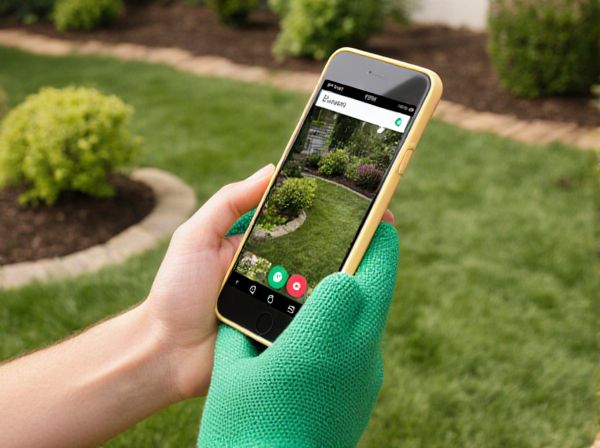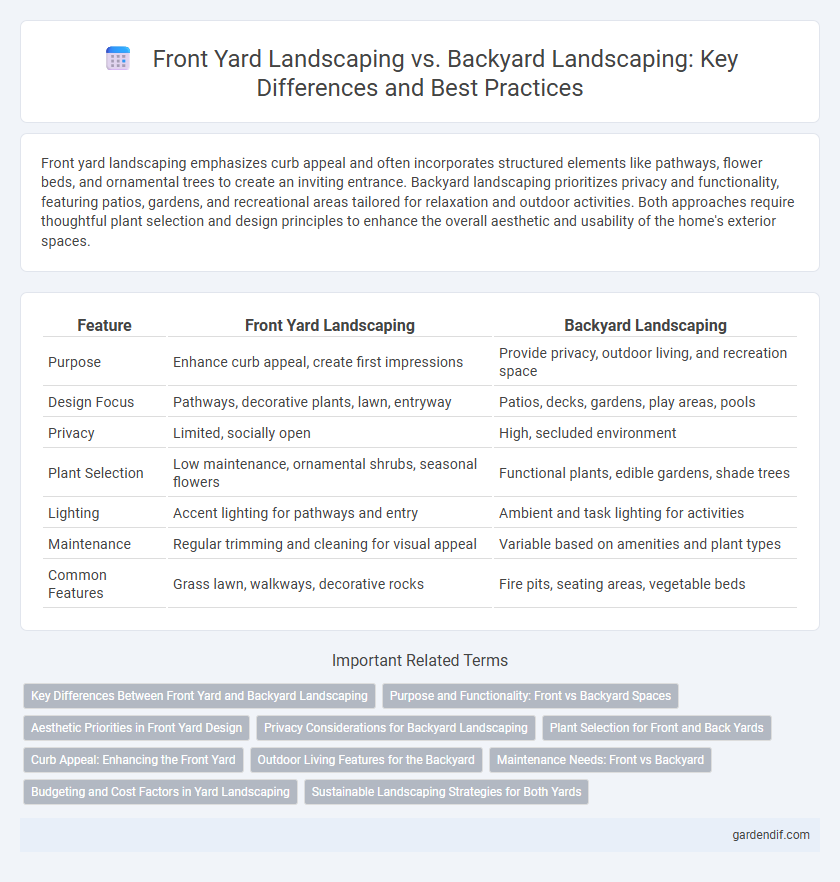
Front Yard Landscaping vs Backyard Landscaping Illustration
Front yard landscaping emphasizes curb appeal and often incorporates structured elements like pathways, flower beds, and ornamental trees to create an inviting entrance. Backyard landscaping prioritizes privacy and functionality, featuring patios, gardens, and recreational areas tailored for relaxation and outdoor activities. Both approaches require thoughtful plant selection and design principles to enhance the overall aesthetic and usability of the home's exterior spaces.
Table of Comparison
| Feature | Front Yard Landscaping | Backyard Landscaping |
|---|---|---|
| Purpose | Enhance curb appeal, create first impressions | Provide privacy, outdoor living, and recreation space |
| Design Focus | Pathways, decorative plants, lawn, entryway | Patios, decks, gardens, play areas, pools |
| Privacy | Limited, socially open | High, secluded environment |
| Plant Selection | Low maintenance, ornamental shrubs, seasonal flowers | Functional plants, edible gardens, shade trees |
| Lighting | Accent lighting for pathways and entry | Ambient and task lighting for activities |
| Maintenance | Regular trimming and cleaning for visual appeal | Variable based on amenities and plant types |
| Common Features | Grass lawn, walkways, decorative rocks | Fire pits, seating areas, vegetable beds |
Key Differences Between Front Yard and Backyard Landscaping
Front yard landscaping emphasizes curb appeal, incorporating elements like symmetrical planting beds, walkways, and decorative features to enhance the home's exterior appearance. Backyard landscaping prioritizes privacy and functionality, often featuring spaces for recreation, gardening, and outdoor living areas such as patios or decks. Design considerations vary, with front yards demanding formal aesthetics and backyards allowing for more personalized, casual layouts tailored to homeowners' lifestyles.
Purpose and Functionality: Front vs Backyard Spaces
Front yard landscaping typically emphasizes curb appeal and aesthetic value, designed to create an inviting first impression that enhances property value. Backyard landscaping prioritizes functionality and privacy, often incorporating spaces for recreation, relaxation, and outdoor living with features like patios, gardens, or play areas. The divergent purposes of front and backyard spaces dictate distinct design approaches, balancing beauty in the front with usability and comfort in the back.
Aesthetic Priorities in Front Yard Design
Front yard landscaping prioritizes curb appeal by emphasizing symmetrical plantings, well-defined pathways, and vibrant seasonal flowers that enhance the home's architectural features. Incorporating focal points such as ornamental trees, shrubs, and accent lighting establishes an inviting atmosphere that complements neighborhood aesthetics. Front yard design balances beauty with functionality, ensuring visibility from the street while maintaining low-maintenance greenery to uphold year-round visual impact.
Privacy Considerations for Backyard Landscaping
Backyard landscaping prioritizes privacy by incorporating elements like tall hedges, privacy screens, and strategically placed trees to create secluded outdoor living spaces. Unlike front yard landscaping, which focuses on curb appeal and openness, backyard designs often use fences, pergolas, and dense foliage to block views and reduce noise. These privacy considerations enhance comfort and security, transforming the backyard into a private retreat for relaxation and entertainment.
Plant Selection for Front and Back Yards
Front yard landscaping often features ornamental plants like boxwoods, hydrangeas, and flowering shrubs that enhance curb appeal and provide structure. Backyard landscaping prioritizes functional and diverse plant selections such as fruit trees, vegetable gardens, and shade-providing trees like maples or oaks, catering to recreation and privacy. Choosing native and drought-tolerant species optimizes maintenance and sustainability for both front and back yard areas.
Curb Appeal: Enhancing the Front Yard
Front yard landscaping is crucial for curb appeal, creating a welcoming first impression through well-designed plantings, pathways, and lighting that highlight architectural features. Utilizing native plants and low-maintenance shrubs enhances aesthetic value while ensuring sustainability and ease of care. In contrast, backyard landscaping prioritizes privacy and functionality, often incorporating patios and recreational spaces rather than focusing on visual impact from the street.
Outdoor Living Features for the Backyard
Backyard landscaping often prioritizes outdoor living features such as patios, fire pits, and outdoor kitchens, creating multifunctional spaces for relaxation and entertainment. Unlike front yard landscaping, which emphasizes curb appeal and aesthetic design, backyard landscaping integrates functional elements like seating areas, pergolas, and water features to enhance usability and comfort. Incorporating garden lighting, privacy screens, and built-in grills transforms the backyard into a versatile extension of indoor living, maximizing the property's recreational potential.
Maintenance Needs: Front vs Backyard
Front yard landscaping typically demands higher maintenance due to its visibility and aesthetic expectations, requiring regular mowing, pruning, and seasonal planting to maintain curb appeal. Backyard landscaping often allows for more flexible design choices such as naturalistic plantings or recreational spaces, which can reduce maintenance frequency compared to the structured upkeep of front yards. Both areas benefit from selecting native, drought-tolerant plants to minimize watering and care requirements, but front yards generally require more consistent attention to meet neighborhood standards.
Budgeting and Cost Factors in Yard Landscaping
Front yard landscaping typically demands a higher budget due to curb appeal enhancements like premium plants, decorative stones, and lighting installations, which are crucial for first impressions. Backyard landscaping costs vary widely, influenced by features such as patios, decks, irrigation systems, and privacy fences, often allowing more budget flexibility based on functional use. Homeowners should account for factors like soil preparation, plant selection, labor costs, and ongoing maintenance when comparing front yard versus backyard landscaping expenses.
Sustainable Landscaping Strategies for Both Yards
Front yard landscaping emphasizes curb appeal and often incorporates drought-tolerant plants and permeable paving to reduce water runoff, promoting sustainability. Backyard landscaping allows for more diverse sustainable strategies such as rain gardens, composting areas, and native plant beds that support local biodiversity. Implementing sustainable practices in both yards maximizes water conservation, soil health, and energy efficiency throughout the entire property.
Front Yard Landscaping vs Backyard Landscaping Infographic

 gardendif.com
gardendif.com